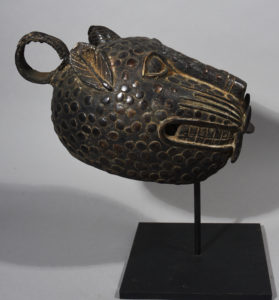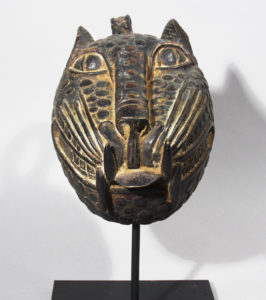CMK 0307-03a
Benin Bronze Leopard Head, Benin, Nigeria
The Benin people of Nigeria believe that the Benin leopard is a symbol of justice as well as a strong animal that has royal qualities. And just as the Leopard is believed to rule over Savannah, so the King of Oba wants to be compared to his subjects.
This dramatic and at the same time beautiful leopard head in bronze is thus a royal icon and was often used as a royal water fountain. Water was poured from this head over Obama’s hands in purifying rituals.
TheBeninKingdomwasstrongthroughoutthe15thand16thCenturiesandwaslocatedinWestAfricaborderingwhatisnowNigeriaandTogo.BeninClanswereruledbyaKing,whowasknownastheObaandwhowasthedivineruleroftheBeninpeople.ThepeopleofBeninarecalledBiniandaredescendedfromtheIfepeoples.ThemakingsoftheseBeninbronzeswerestrictlyconsideredcourtartandweremadeexclusivelyforthepalaceoftheObaandweredesignedtoveneratetheachievementsandmemoriesoftheObasandtheirQueensalsocalledIyobasorQueenMotherswhoruledthroughoutthetimeofthekingdom.
The bronze founders were incredibly talented and used complex wax casting techniques, which were far ahead of their time. Their work in bronze, copper and iron was extremely refined and their methods of metal smelting, forging and lost wax methods exceeded any seen in Europe until the 19th century. Lost-wax casting sometimes called by the French name of cire perdue (from the Latin cera perduta) is the process by which a brass or bronze sculpture is cast from artists carving usually made from wax. Very intricate works can be achieved with this method, depending on the carver’s skills. Most everyday Benin objects were made for and associated with court ceremonies. The figures of a leopard were the sole property of the Oba – the leopard was the royal animal.
Age: Although similar to much older works, this is est. early-mid-20th.
Measure: H: 15, W: 14, L: 28 cm – Weight: 3100 grams
Condition: Despite their age, this leopard head is in exceptionally good condition. The fine and delicate leopard markings stand with a dark brown bronze glow. No damage or defects in the figures.
Provenience: Belgian private collection (acquired through a Brussels art dealer).
Literature – books:
“The Kingdom of Benin in West Africa” by Heather Millar. Reviewed by Dan Ben-Amos.
“Benin Kingdom of West Africa” by John Peffer-Engels
“The Bini People of the Benin Kingdom” by Chukwuma Azuonye. Reviewed by Joseph Nevadomsky
“Höfische Elfenbeinschnitzerei im Reich Benin”: Kontinuität oder Kontinuitätspostulät by Stefan – Eisenhofer. Reviewed by Barbara W. Blackmun
“Lamidi Olonade Fakeye”: A Retrospective Exhibition and Autobiography by Lamidi Olonade Fakeye – and Bruce M. Haight. Reviewed by Jean M. Borgatti.
Request price for Benin Bronze





